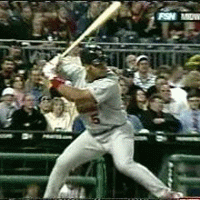quote:Originally posted by powertoallfields:
You think Pujols' hips don't clear until after contact in this clip?
http://hittingillustrated.com/library/Pujols8.gif
To me from the perspective of what I have seen taught, again - semantics and verbal cues - Pujols' foot is essentially closed here. Not to the extent of a previous clip that appeared here, which was quite dramatic, but to the degree that his foot is positioned after the swing, his foot is closed off.
Again, the problem is to what degree do you believe I infer when I say a "closed foot"...this to me is closed.


